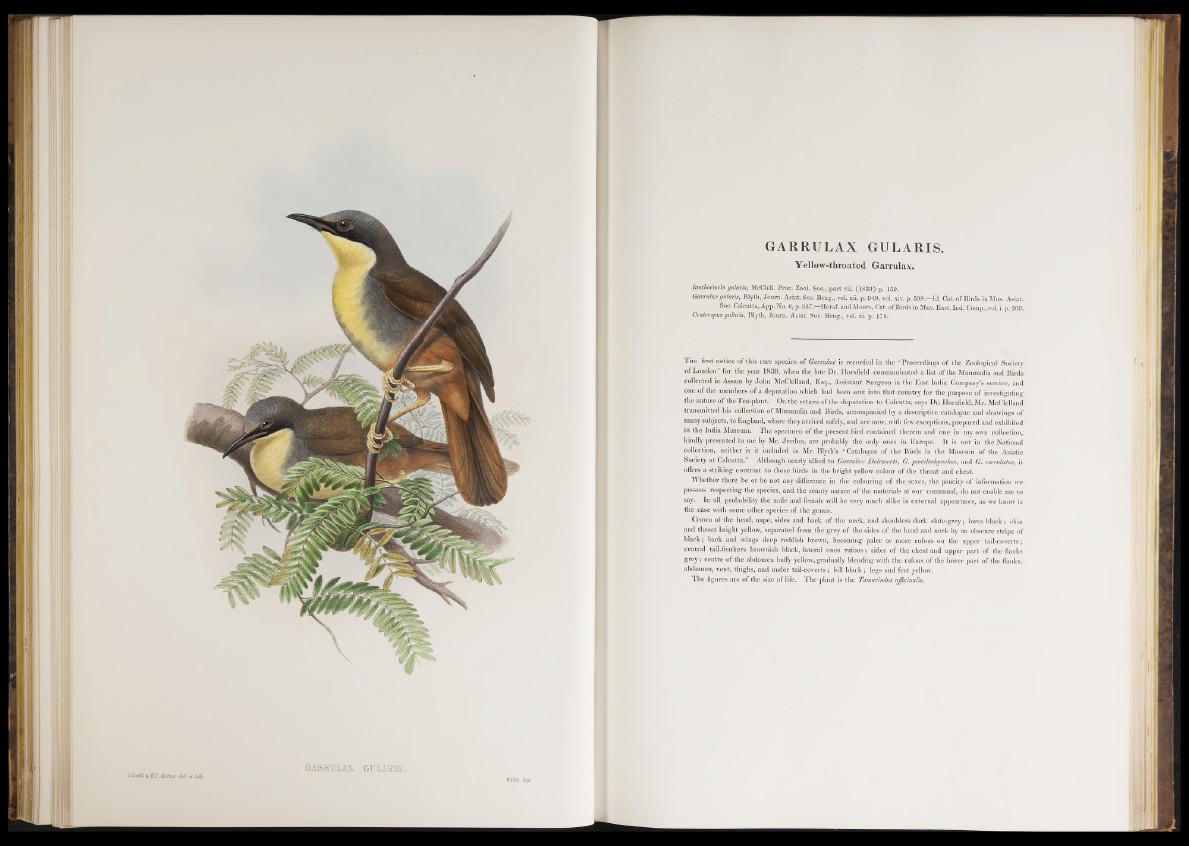
■T. Gould/ b HC.Richter, del <1 lith
GÄKRULAX GÜUH3.
Walter, Im p.
GARRULAX GULARIS.
Yellow-throated Garrulax,
Ianthocincla gularis, McClell. Proc. Zool. Soc., part vii. (1 839) p. 159.
Garrulax gularis, Blyth, Joum. Asiat. Soc. Beug., vol. xii. p. 949, vol. xiv. p. 598.—Id. Cat. of Birds in Mus. Asiat.
Soc. Calcutta, App. No. 6, p. 337.—Horsf. and Moore, Cat. o f Birds in Mus. East. Ind. Comp., vol. i. p. 203.
Cr ater opus gularis, Blyth, Joum. Asiat. Soc. Beng., vol. xi. p. 179.
T h e first notice of this rare species of Garrulax is recorded in the ‘ Proceedings o f the Zoological Society
of London’ for the year 1839, when the late Dr. Horsfield communicated a list of the Mammalia and Birds
collected in Assam by John McClelland, Esq., Assistant Surgeon in the East India Company’s service, and
one of the members o f a deputation which had been sent into that country for the purpose of investigating
the nature o f the Tea-plant. On the return of the deputation to Calcutta, says Dr. Horsfield, Mr. McClelland
transmitted his collection of Mammalia and Birds, accompanied by a descriptive catalogue and drawings of
many subjects, to England, where they arrived safely, and are now, with few exceptions, prepared and exhibited
in the India Museum. The specimen of the present bird contained therein and one in my own collection,
kindly presented to me by Mr. Jerdon, are probably the only ones in Europe. It is not in the National
collection, neither is it included in Mr. Blyth’s ‘ Catalogue of the Birds in the Museum of the Asiatic
Society at Calcutta.” Although nearly allied to Garrulax Delesserti, G. pcecilorhynchus, and G. caerulatus, it
offers a striking contrast to those birds in the bright yellow colour of the throat and chest.
Whether there be or be not any difference in the colouring of the sexes, the paucity of information we
possess respecting the species, and the scanty nature of the materials a t our command, do not enable me to
say. In all probability the male and female will be very much alike in external appearance, as we know is
the case with some other species o f the genus.
Crown of the head, nape, sides and back o f the neck, and shoulders dark slate-grey; lores black; chin
and throat bright yellow, separated from the grey of the sides of the head and neck by an obscure stripe of
b lack; back and wings deep reddish brown, becoming paler or more rufous on the upper tail-coverts;
central tail-feathers brownish black, lateral ones rufous; sides of the chest and upper part of the flanks
g rey ; centre o f the abdomen bufly yellow, gradually blending with the rufous of the lower part of the flanks,
abdomen, vent, thighs, and under tail-coverts; bill black ; legs and feet yellow.
The figures are o f the size o f life. The plant is the Tamarindus officinalis.